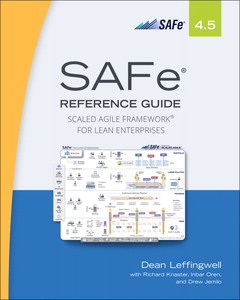SAFe 4.5 Reference Guide (2nd Ed.) Scaled Agile Framework for Lean Enterprises
Auteur : Leffingwell Dean

SAFe was developed from real-world field experience and provides proven success patterns for implementing Lean-Agile software and systems development at enterprise scale. This book provides comprehensive guidance for work at the enterprise Portfolio, Large Solution, Program, and Team levels, including the various roles, activities, and artifacts that constitute the Framework. The practice of SAFe is spreading rapidly throughout the world. The majority of Fortune 100 companies have certified SAFe professionals and consultants, as do an increasing percentage of the Global 2000.
Successful implementations may vary in context but share a common attribute: a workforce well trained and educated in SAFe practices. This book?along with authorised training and certification?will help you understand how to maximise the value of your role within a SAFe organisation. The result is greater alignment and visibility, improved performance throughout the enterprise, and ultimately better outcomes for the business.
Preface x
About the Authors xii
Acknowledgments xiii
Introduction to the Scaled Agile Framework (SAFe) 1
Part 1: The SAFe Foundation 13
Lean-Agile Leaders 15
Core Values 21
Lean-Agile Mindset 27
SAFe Principles Overview 35
SAFe Implementation Roadmap Overview 39
SAFe Program Consultant 43
Part 2: The SAFe Implementation Roadmap 47
Reaching the Tipping Point 49
Train Lean-Agile Change Agents 53
Train Executives, Managers, and Leaders 57
Create a Lean-Agile Center of Excellence 63
Identify Value Streams and ARTs 69
Create the Implementation Plan 83
Prepare for ART Launch 89
Train Teams and Launch the ART 99
Coach ART Execution 105
Launch More ARTs and Value Streams 109
Extend to the Portfolio 119
Sustain and Improve 125
Part 3: The SAFe Principles 133
Principle #1: Take an economic view 135
Principle #2: Apply systems thinking 141
Principle #3: Assume variability; preserve options 145
Principle #4: Build incrementally with fast, integrated learning cycles 147
Principle #5: Base milestones on objective evaluation of working systems 151
Principle #6: Visualize and limit WIP, reduce batch sizes, and manage queue lengths 155
Principle #7: Apply cadence, synchronize with cross-domain planning 159
Principle #8: Unlock the intrinsic motivation of knowledge workers 163
Principle #9: Decentralize decision-making 167
Part 4: The Team Level 171
Team Level 173
Agile Teams 177
Dev Team 183
Product Owner 187
Scrum Master 193
Built-In Quality 197
ScrumXP 203
Story 209
Iterations 219
Iteration Planning 223
Iteration Goals 229
Iteration Execution 233
Iteration Review 241
Iteration Retrospective 245
Team Backlog 249
Team Kanban 253
Part 5: The Program Level 259
Introduction to the Program Level 261
Agile Release Train 265
Business Owners 275
Product and Solution Management 281
Release Train Engineer and Solution Train Engineer 287
System and Solution Architect/Engineering 291
Program and Solution Backlogs 297
Features and Capabilities 305
Enablers 311
Nonfunctional Requirements 317
Weighted Shortest Job First 325
Program Increment 329
Innovation and Planning Iteration 335
Develop on Cadence 341
Release on Demand 345
Architectural Runway 353
PI Planning 361
PI Objectives 371
System Demo 379
Inspect and Adapt 383
Program and Solution Kanban 391
DevOps 397
Continuous Delivery Pipeline 405
Continuous Exploration 413
Continuous Integration 419
Continuous Deployment 427
Part 6: The Spanning Palette 433
Metrics 435
Shared Services 457
Communities of Practice 461
Milestones 467
Roadmap 475
Vision 481
System Team 487
Lean UX 491
Part 7: The Large Solution Level 497
Introduction to the Large Solution Level 499
Solution Train 503
Customer 509
Supplier 513
Economic Framework 519
Pre- and Post-PI Planning 523
Solution Demo 531
Solution 535
Solution Context 539
Solution Intent 545
Compliance 553
Model-Based Systems Engineering 561
Set-Based Design 567
Part 8: The Portfolio Level 575
Introduction to the Portfolio Level 577
Enterprise 581
Value Streams 587
Strategic Themes 593
Lean Budgets 599
Epic 609
Epic Owners 615
Enterprise Architect 619
Lean Portfolio Management 623
Portfolio Backlog 631
Portfolio Kanban 635
Value Stream Coordination 639
Part 9: Advanced Topics 643
Agile Architecture 645
Agile Contracts 653
Agile HR with SAFe 661
CapEx and OpEx 673
Enterprise Backlog Structure and Management 683
Essential SAFe 691
Features and Components 695
Invitation-Based SAFe Implementation 701
Refactoring 709
SAFe Requirements Model 715
Six SAFe Practices for S-Sized Teams 717
Spikes 723
Test-First 727
The Role of PI Objectives 733
Part 10: Glossary 737
SAFe Glossary 739
Bibliography 749
Index 755
Leverage the Scaled Agile Framework® (SAFe) to achieve agility at any scale
- Gain an in-depth understanding of the Scaled Agile Framework, learn to implement it successfully, and apply it to deliver breakthrough performance
- Overcome the organizational obstacles to business and software agility
- Use "lean thinking" to help your teams continuously improve programs and performance
- By Dean Leffingwell, one of the world's leading experts on large-scale agile development
Date de parution : 07-2018
Ouvrage de 816 p.
20.2x25.2 cm
Disponible chez l'éditeur (délai d'approvisionnement : 14 jours).
Prix indicatif 52,74 €
Ajouter au panierThème de SAFe 4.5 Reference Guide :
Mots-clés :
agile; SAFe; Scaled Agile Framework; Large-scale agile; Scrum; large-scale scrum



